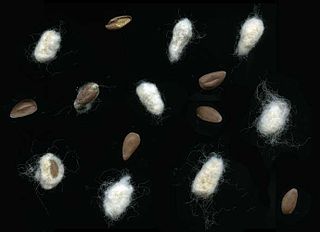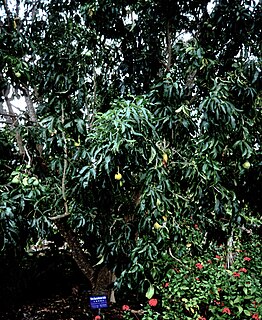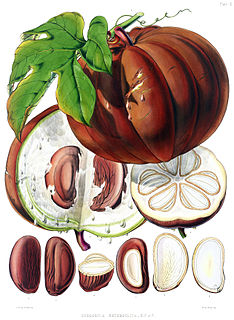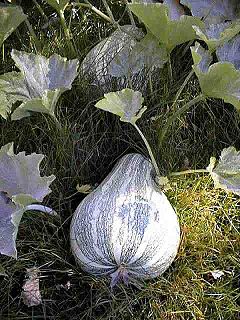Related Research Articles

Azadirachta indica, commonly known as neem, nimtree or Indian lilac, is a tree in the mahogany family Meliaceae. It is one of two species in the genus Azadirachta, and is native to the Indian subcontinent and most of the countries in Africa. It is typically grown in tropical and semi-tropical regions. Neem trees also grow on islands in southern Iran. Its fruits and seeds are the source of neem oil.

The cashew tree is a tropical evergreen tree that produces the cashew seed and the cashew apple pseudofruit. The tree can grow as high as 14 m (46 ft), but the dwarf cultivars, growing up to 6 m (20 ft), prove more profitable, with earlier maturity and greater yields.

The persimmon is the edible fruit of a number of species of trees in the genus Diospyros. The most widely cultivated of these is the Oriental persimmon, Diospyros kaki. Diospyros is in the family Ebenaceae, and a number of non-persimmon species of the genus are grown for ebony timber. In 2019, China produced 75% of the world total of persimmons.

Juniperus virginiana, also known as red cedar, eastern red cedar, Virginian juniper, eastern juniper, red juniper, and other, local names, is a species of juniper native to eastern North America from southeastern Canada to the Gulf of Mexico and east of the Great Plains. Further west it is replaced by the related Juniperus scopulorum and to the southwest by Juniperus ashei.

Cottonseed oil is cooking oil from the seeds of cotton plants of various species, mainly Gossypium hirsutum and Gossypium herbaceum, that are grown for cotton fiber, animal feed, and oil.

Pumpkin seed oil is a culinary oil, used especially in central Europe.

Attalea maripa, commonly called maripa palm is a palm native to tropical South America and Trinidad and Tobago. It grows up 35 m (115 ft) tall and can have leaves or fronds 10–12 m (33–39 ft) long. This plant has a yellow edible fruit which is oblong ovoid and cream. An edible oil can be extracted from the pulp of the fruit and from the kernel of the seed.

Citrullus colocynthis, with many common names including colocynth, bitter apple, bitter cucumber, desert gourd, egusi, vine of Sodom, or wild gourd, is a desert viny plant native to the Mediterranean Basin and Asia, especially Turkey, and Nubia.

Pouteria sapota, the mamey sapote, is a species of tree native to Mexico and Central America. The tree is also cultivated in the Caribbean. Its fruit is eaten in many Latin American countries. The fruit is made into foods such as milkshakes and ice cream.

The white sapote, also called casimiroa and Mexican apple, and known as cochitzapotl in the Nahuatl language is a species of tropical fruiting tree in the family Rutaceae, native to eastern Mexico and Central America south to Costa Rica. The genus is named for "an Otomi Indian, Casimiro Gómez, from the town of Cardonal in Hidalgo, Mexico, who fought and died in Mexico's war of independence."

Hodgsonia is a small genus of fruit-bearing vines in the family Cucurbitaceae.

Cucurbita foetidissima is a tuberous xerophytic plant found in the central and southwestern United States and northern Mexico. It has numerous common names, including: buffalo gourd, calabazilla, chilicote, coyote gourd, fetid gourd, fetid wild pumpkin, Missouri gourd, prairie gourd, stinking gourd, wild gourd, and wild pumpkin. The type specimen was collected from Mexico by Alexander von Humboldt and Aimé Bonpland sometime before 1817.

Attalea is a large genus of palms native to Mexico, the Caribbean, Central and South America. This pinnately leaved, non-spiny genus includes both small palms lacking an aboveground stem and large trees. The genus has a complicated taxonomic history, and has often been split into four or five genera based on differences in the male flowers. Since the genera can only be distinguished on the basis of their male flowers, the existence of intermediate flower types and the existence of hybrids between different genera has been used as an argument for keeping them all in the same genus. This has been supported by recent molecular phylogenies.
Malvalic acid is a cyclopropene fatty acid found in baobab seed oil and cottonseed oil. The cyclopropene ring is thought to be one of the causes of abnormalities that develop in animals that ingest cottonseed oil. Refining processes, such as hydrogenation, can remove or destroy malvalic acid.

An apple is an edible fruit produced by an apple tree. Apple trees are cultivated worldwide and are the most widely grown species in the genus Malus. The tree originated in Central Asia, where its wild ancestor, Malus sieversii, is still found today. Apples have been grown for thousands of years in Asia and Europe and were brought to North America by European colonists. Apples have religious and mythological significance in many cultures, including Norse, Greek, and European Christian tradition.

Mono- and diglycerides of fatty acids (E471) refers to a naturally occurring class of food additive composed of diglycerides and monoglycerides which is used as an emulsifier. These of diglycerides and monoglycerides have no limit for daily intake and are used as a fruit coating agent. This mixture is also sometimes referred to as partial glycerides.

Cucurbita argyrosperma, also the Japanese pie pumpkin or cushaw pumpkin, and silver-seed gourd, is a species of winter squash originally from the south of Mexico. This annual herbaceous plant is cultivated in the Americas for its nutritional value: its flowers, shoots, and fruits are all harvested, but it is cultivated most of all for its seeds, which are used for sauces. It was formerly known as Cucurbita mixta.

Kusum oil is a type of oil extracted from the seed of the Kusum tree. The plant, which is also commonly known as Ceylon oak, lac tree, or Macassar oiltree, belongs to the family Sapindaceae. The schleichera family is named after J. C. Schleicher, a Swiss botanist, and the species name means "oily" or "rich in oil." The tree is native to South Asia, but is also found in some parts of Southeast Asia.
Allanblackia oil is a vegetable oil that comes from the seeds of trees of the genus Allanblackia. This tree can be found in the wet tropical belt of Africa. Because of its unique blend of fatty acids, the oil from Allanblackia seeds has melting properties that make it excellent to use as structuring fat in food products, e.g. margarines.
References
- ↑ Jamieson, G. S.; McKinney, R. S. (1931). "Sapote (mammy apple) seed and oil". Oil & Fat Industries. 8 (7): 255–256. doi:10.1007/BF02574575. S2CID 101373525.
- ↑ Jules Janick, Robert E. Paull, ed. (2008). The encyclopedia of fruit & nuts. CABI. ISBN 978-0-85199-638-7.
- ↑ G. S. Jamieson and R. S. McKinney (1931). "Sapote (mammy apple) seed and oil". Journal of the American Oil Chemists' Society. 8 (7): 255–256. doi:10.1007/BF02574575. S2CID 101373525.